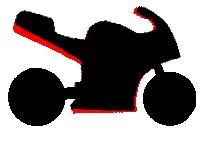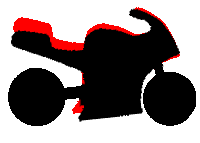Motorcycle Suspension Setup - Day 4
DAY 4 - REAR DAMPING
 Kick Up
Kick Up  Squatting
Squatting
Once you are done with the preload and front wheel damping let move onto the rear wheel. You can set it based on comfort and uneven road using the same methods as you would with the front wheel. Also you could try to do what’s called:
Suspension Balance
Take the bike off its stand onto level ground and stand next to it. While holding your motorcycle upright, put one foot on the foot peg next to you and press hard on it. The front and rear of the bike should squash down and raise at the same rate. If not adjust rear damping compression and rebound to compensate.
Now you have a comfortable bike with adequate suspension balance. Now let’s fine tune it a bit. Again there are no tricks to setting up your rear wheel suspension, you have to understand what causes your rear suspension to work. Since rebound occurs after compression we will deal with compression first.
Rear Compression
Like with the front wheel; if your rear compression is too hard you will have an uncomfortable ride because the rear wheel simply bounces off bumps and ripples in the road also giving a vague “feel”. Conversely, if it is too soft, you may get excessive “squatting” under heavy acceleration causing the bike to feel lethargic or even “bottoming out” on those rough roads.
When you accelerate, you need a bit of rear end squatting to give the tyres a chance to get some traction and absorb excessive power to the back wheel. However, it is that squatting action under heavy acceleration that can cause problems when coming out of corners.
SOFT: Let’s imagine that you are exiting a corner on your motorcycle, and the bike is leant over and you start to accelerate smartly. If the compression damping is too soft, you will get too much rear end “squatting” causing a “nose up” situation. This will cause your bike to drift wide on exit of the corner. This is not the same as a too much of front compression damping which causes the bike to drift wide on entry to the corner.
HARD: On the other hand if your rear compression damping is too hard, you will not get enough “squatting” and therefore may not get enough traction. This will cause a bit of rear wheel spin, or the rear wheel suddenly “kicking up”. You can imagine what can happen in extreme circumstances.
To set your rear compression damping up properly, it is best to have the front end sorted out first. That way you know you that your entry into the corner is as smooth as possible. Then you want to be able to put on the gas as you exit the corner and your bike should hold its line and inspire confidence.
Rear Rebound
Nearly the end of this setting up drivel. You have exited the corner and the bike is now flying forward in a straight line. At this point you want the rear rebound damping to keep the rear wheel in contact with the road, thereby giving you maximum traction
SOFT: However if it is a long corner then your rear rebound will come into play mid-corner. If your rear wheel kicks up too quickly, it will unsettle the chassis of the bike making it “wallow” and “lurch” mid corner. A lot of people wrongly try to cure mid comer “wallowing” by increasing rear preload. This may "stiffen" the rear end but you may loose a bit of suspension travel. The cure is to increase (harden) rear rebound.
HARD: However if your rear suspension is too hard, your back wheel will not sit up quick enough. This will cause you the have the back end squatting causing a “nose up “ situation for longer. This may cause you to drift wide similar to the effects of soft compression. Also since the rear shock does not extend quick enough, you may get a feeling of vagueness or loss of traction
That’s it.
If you have reached this point and found out that your original set up was the best then oops sorry. At least you have a few more buzz words to drop in the pub with other bike mates.
Sean Onipede - Click here for Motorcycle Suspension Setup Forum
 Kick Up
Kick Up  Squatting
SquattingOnce you are done with the preload and front wheel damping let move onto the rear wheel. You can set it based on comfort and uneven road using the same methods as you would with the front wheel. Also you could try to do what’s called:
Suspension Balance
Take the bike off its stand onto level ground and stand next to it. While holding your motorcycle upright, put one foot on the foot peg next to you and press hard on it. The front and rear of the bike should squash down and raise at the same rate. If not adjust rear damping compression and rebound to compensate.
Now you have a comfortable bike with adequate suspension balance. Now let’s fine tune it a bit. Again there are no tricks to setting up your rear wheel suspension, you have to understand what causes your rear suspension to work. Since rebound occurs after compression we will deal with compression first.
Rear Compression
Like with the front wheel; if your rear compression is too hard you will have an uncomfortable ride because the rear wheel simply bounces off bumps and ripples in the road also giving a vague “feel”. Conversely, if it is too soft, you may get excessive “squatting” under heavy acceleration causing the bike to feel lethargic or even “bottoming out” on those rough roads.
When you accelerate, you need a bit of rear end squatting to give the tyres a chance to get some traction and absorb excessive power to the back wheel. However, it is that squatting action under heavy acceleration that can cause problems when coming out of corners.
SOFT: Let’s imagine that you are exiting a corner on your motorcycle, and the bike is leant over and you start to accelerate smartly. If the compression damping is too soft, you will get too much rear end “squatting” causing a “nose up” situation. This will cause your bike to drift wide on exit of the corner. This is not the same as a too much of front compression damping which causes the bike to drift wide on entry to the corner.
HARD: On the other hand if your rear compression damping is too hard, you will not get enough “squatting” and therefore may not get enough traction. This will cause a bit of rear wheel spin, or the rear wheel suddenly “kicking up”. You can imagine what can happen in extreme circumstances.
To set your rear compression damping up properly, it is best to have the front end sorted out first. That way you know you that your entry into the corner is as smooth as possible. Then you want to be able to put on the gas as you exit the corner and your bike should hold its line and inspire confidence.
Rear Rebound
Nearly the end of this setting up drivel. You have exited the corner and the bike is now flying forward in a straight line. At this point you want the rear rebound damping to keep the rear wheel in contact with the road, thereby giving you maximum traction
SOFT: However if it is a long corner then your rear rebound will come into play mid-corner. If your rear wheel kicks up too quickly, it will unsettle the chassis of the bike making it “wallow” and “lurch” mid corner. A lot of people wrongly try to cure mid comer “wallowing” by increasing rear preload. This may "stiffen" the rear end but you may loose a bit of suspension travel. The cure is to increase (harden) rear rebound.
HARD: However if your rear suspension is too hard, your back wheel will not sit up quick enough. This will cause you the have the back end squatting causing a “nose up “ situation for longer. This may cause you to drift wide similar to the effects of soft compression. Also since the rear shock does not extend quick enough, you may get a feeling of vagueness or loss of traction
That’s it.
If you have reached this point and found out that your original set up was the best then oops sorry. At least you have a few more buzz words to drop in the pub with other bike mates.
Sean Onipede - Click here for Motorcycle Suspension Setup Forum

0 Comments:
Post a Comment
Subscribe to Post Comments [Atom]
<< Home